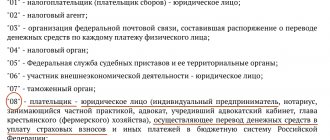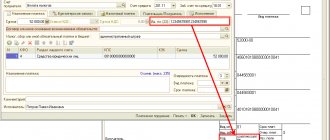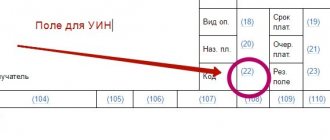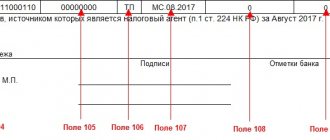Innovations
Any organization or individual entrepreneur becomes a taxpayer from the moment of state registration and assignment of a TIN. From that moment on, they have the obligation to pay taxes and submit returns to the Federal Tax Service. The new procedure for processing payments includes the following changes:
- The exact number of characters in lines “60” (TIN) and “103” (KPP) is clearly stated. The TIN of individuals consists of 12 digits, and of legal entities - of 10. The checkpoint consists of 9 characters. Both codes cannot start with "00".
- The new UIN details may include 20 or 25 characters. KBK - 20 digits, OKTMO - 8 or 11. Moreover, none of the listed codes can contain only “0”.
- A new mandatory payment detail has appeared - “Basis of payment” (106). State duty, fine, penalty and regular debt repayment are listed under different codes.
A number of changes affected the rules for filling out the “Payment Type” field (110). When paying taxes and fees, you do not need to fill in this information. But the code for the subtype of income should be reflected in the KBK. This will be used to identify the payment:
- 2100 - transfer of penalties;
- 2200 - interest payment.
Let's take a closer look at all these changes.
Payment of state duty basis of payment
Fields from 101 to 110 are filled in by payers or authorized persons for the payment of various tax fees, state duties, fines, penalties, etc. They indicate information that is established by the Ministries of Taxes and Duties and the Ministry of Finance, as well as the Customs Committee. Each field from 101 to 110 is filled in only when making a payment for the transfer of the tax contribution, as well as such fees as state duty, fine and other similar obligations for payment under these items. For other cases, these fields should be left blank.
A familiar situation, if all documents contain e - contact the registry office for correction. our situation was worse - all the documents issued after the birth certificate had the letter e and not e - we had to change our passport, pension, diploma, and the letter about the equality of the letters was of no use, they refused to privatize our housing
Payment order
This is a payment document with which the payer transfers funds from his account. This document is used to pay for goods, services, taxes and fees. It can be drawn up on paper or electronically using the BankClient system. The form of the document is approved by Regulation No. 383P “On the rules for conducting the transfer of funds in domestic currency on the territory of the Russian Federation.” The information is entered into the payment order in encoded form. This is necessary for quick accounting of payments and automated document flow between all participants in legal relations. Let's take a closer look at the order in which each column is filled in.
Basis for payment of state duty to the court
Hello. From your question, I understand that you have not had a trial yet. Therefore, it will not hurt you to be accompanied by a lawyer in your case and get advice. I am a lawyer with a higher education, for a small fee I can help you minimize your costs and advise you in more detail. If you agree, write by email.
The instruction has been sent to the bank that maintains the payer’s account. Funds are transferred from a deposit account. If for some reason the account does not have the required amount of money, but the agreement between the bank and the payer provides for an overdraft, the transfer will be carried out. This document must be drawn up and submitted to the bank for execution in electronic or paper form.
We recommend reading: Is it possible to report 3NDFL for 2020 now?
Sequence
Art. 855 of the Civil Code of the Russian Federation provides for 5 orders of payments. For clarity, we present the information in the form of a table.
| 1 | Execution documents for harm caused to human health and life; for alimony. |
| 2 | Executive documents for severance pay, wages; remuneration to authors. |
| 3 | Documents on wages, taxes, fees, transfers to extra-budgetary funds. |
| 4 | Other executive documents. |
| 5 | Other payment documents. |
Basis of Payment When Paying State Duty to Court
Third According to payment documents for settlements of wages with persons working under an employment agreement (contract), instructions from tax authorities to write off and transfer debts for taxes and fees, instructions from state extra-budgetary funds to write off and transfer amounts of insurance contributions. Fourth According to executive documents not related to the first and second stages.
Since the law has come into force, and it must be observed until another regulatory legal act is adopted that repeals or changes it. Queue of payment when transferring own funds First, it should be said that there are now only 5 queues for writing off funds from the payer’s account.
03 Feb 2021 etolaw 675
Share this post
- Related Posts
- Veteran of Labor Does Not Pay Personal Income Tax on Salary
- How long after birth should a child be registered?
- Gas station Premises Owned Land Rent
- What Documents Are Required to Renew a Passport at 20 Years of Age?
Required details
The same form number of the form is always indicated in the upper right corner - 0401060. Next, the serial number of the document is written. It is assigned by the bank and consists of 6 digits. Identification is carried out using the last three digits.
The date is entered in the format DD.MM.YYYY. If a document is sent via Internet banking, the system assigns the required format independently. If the document is drawn up on paper, then it is important not to confuse the first two indicators.
The type of payment is specified in the form of a code approved by the bank. The amount in words is indicated only in paper payments. The same information is duplicated separately in numbers. Rubles are separated from small change by a sign (“”). If the amount is indicated without kopecks, then you can put the “=” sign (7575=).
In the “Payer” field, the legal entity indicates its abbreviated name. If the payment is sent abroad, the address of the location is additionally indicated. Individual entrepreneurs and individuals indicate their full names. (in full) and legal status. In the case of an international payment, the address of residence is additionally indicated. Payment can be made without opening an account. In this case, the document contains the name of the bank and information about the payer: his full name, tax identification number, address. The payer's account must consist of 20 digits.
The document contains the name of the sender and recipient's bank, its address, BIC, correspondent account numbers, and the abbreviated name of the recipient. If the transfer is made through an account opened with another financial institution, then the client’s account number is additionally indicated.
In the “Type of transaction” field the payment code is entered, in the “Payment purpose” - what exactly the payment is for. If we are talking about budget payments, then the information from this field should complement the “Base of payment” (106). Penalties and fines are paid with a unique code, but goods and services are paid without it. After filling out all the fields, the stamp and signature of the bank’s responsible person is affixed.
These are standard details that must be present in any payment document. Now let's look at the additional fields that are filled in when transferring taxes.
What affects the purpose of the payment?
The column allows you to attribute received funds to one or another account within the accounting system for commercial transactions. This can be done either automatically or manually. However, attentive users remember that previously the column was not required to be filled out
. This happened relatively recently. But why?
Bank of Russia Regulation No. 383-P dated June 19, 2012 “On the rules for transferring funds” stipulates the obligation to indicate the “purpose of payment” when carrying out a transaction. The same Regulations note that a transfer of funds by an individual without opening a bank account must also contain the purpose of the payment.
In theory, banks may require documents confirming the correctness of the entered data to complete a transaction. In practice, this happens so rarely that it was not even possible to find a live example on the Internet. However, the payment may be canceled due to incorrect indication of the destination.
Options for filling out the column:
- An exact indication of the purpose of the transaction without reference to the contract (for example, payment for a bicycle, repayment of a debt, payment of interest, gratuitous assistance, etc.);
- The next payment under an open-ended or long-term agreement - indicating the personal account and the nature of the transaction (for example, “payment for electricity for May 2021 under agreement No. 91230”, “rent reimbursement for January 2021 from LLC AAA”, etc.) ;
- Transfer of funds to fulfill obligations under a specific agreement (option: “payment for tourist services under agreement No. 234 dated March 21, 2020”).
It should be noted that other columns are much more important: TIN and account of the recipient, full name and address of the sender. If an error is made in these fields, it is impossible to correct it without going to the bank (and sometimes to the court). But the “purpose of payment” also matters when it comes to special cases.
Correctly filling out the column is extremely important when carrying out various operations:
- Making the next contribution for housing construction or when performing a similar obligation (it is important to indicate the contract number and the period for which the transaction is being carried out);
- Payment for a specific service of an organization that works with a large number of contracts (for example, meals in kindergarten, educational courses);
- Repayment of a fine (the number of the resolution and the date of its issuance will help to exclude the debtor from the database);
- Transfers for the fulfillment of social obligations;
- Transferring money from one of your accounts to another (you should indicate “transfer of your own funds”).
OKTMO
The payment order contains a mandatory field “Basis of payment” (106), the explanation of which will be presented below. Also, according to the new rules, you need to indicate OKTMO instead of OKATO. You can find out the code on the website of the territorial department of state statistics or through the Federal Tax Service service of the same name. To obtain information, you need to select a region, indicate OKATO or municipality. The results may be presented in an abbreviated version. If OKTMO ends with “000”, then the first 8 characters will appear as a result of processing. If OKTMO is 46534426636 (contains 11 characters), then the code will be reflected in full.
Payer status when paying state duty to court 2021
In the payment order for the transfer of funds to the recipient, the payer is required to indicate the status in field 101, as evidenced by the Regulation of the Central Bank of the Russian Federation No. 383-P. This cell is filled in to identify the person making the non-cash payment. In connection with the bill of the Ministry of Finance of the Russian Federation “On Amendments...”, starting from the beginning of 2021, many accountants are wondering if the state duty is paid, should the payer status be 01 or 08 in field 101? This will be discussed in our editorial office. The content of the article
We recommend reading: Is an apartment registered in the name of a wife after the death of her husband but purchased during marriage subject to inheritance?
If the payment type remains blank, then such an order is classified as non-urgent using the appropriate means of transfer. Status 01 Amount The amount should be indicated in words with a capital letter, while the words “rubles” and “kopecks” should be written in full, but the number of kopecks should be written in numbers. Digital designation of the amount:
Payer status (101)
If the “Base of payment” detail (106), the explanation of which will be presented below, identifies the purpose of the funds, then the data in cell “101” determines who is making the transfer. There are 26 payer statuses in total. Let's look at the most popular ones (see table below).
| 01 | Legal face |
| 02 | Agent |
| 06 | Foreign trade participant – legal entity. face |
| 16 | Individual – participant of foreign trade activities |
| 17 | Individual entrepreneur – participant of foreign trade activities |
| 09 | Entrepreneur |
| 10 | Notary |
| 11 | Lawyer with his own office |
| 12 | Head of a farm |
| 13 | Other individual – bank account holder |
| 14 | The taxpayer making payments to individuals. persons |
| 19 | Organizations that transfer funds withheld from salaries |
| 21 | Taxpayer group member |
| 24 | An individual transfers money to pay insurance premiums |
It is also necessary to check whether the transfer matches the status of the sender.
| Payment | Status |
| Personal income tax and VAT are paid by the tax agent (organization, individual entrepreneur) | 02 |
| Taxes are paid by the organization (IP) | 01 (09) |
| Insurance premiums are transferred by the enterprise, individual entrepreneur | 08 |
| Individual entrepreneur transfers fixed contributions | 24 |
If an individual entrepreneur pays personal income tax on his income, then the transaction should be assigned the status “09”. If an entrepreneur pays personal income tax on the income of employees, then he acts as an agent. In this case, you need to indicate the status “02” on the payment.
The status indicated when transferring land tax or income tax depends on the BCC. The table of details is presented in the letter of the Ministry of Finance No. 10/800. Before filling out the document, you should check the data with the table to avoid errors. If the BCC is indicated incorrectly, a tax arrears will arise.
Payments with different statuses are recorded in different personal accounts. If this detail is specified incorrectly, in the internal accounting of the Federal Tax Service the amount will be credited to the debt, which the individual entrepreneur may not have. The tax for which the payment was sent will remain unpaid, even if the details “Base of payment” (106) are registered. The fine and penalty will be charged on the amount of the resulting arrears. Most often, such situations arise in organizations that are both payers and agents.
Payment basis “106”: decryption
Fine, penalty and interest on debt can be repaid on time or in arrears. Based on the information provided in this field, you can understand which document and for what period funds are transferred to the budget. The “Bases of payment” indicator (106) is interconnected with three more lines: period (107), number (108) and date (109) of the document.
Let's look at how to make monthly, quarterly and annual payments:
- Basis of payment (106): TP. Explanation: payment according to current year bills. In this case, the date of signing the document is indicated in field “109”, and “0” is entered in “108”.
- Basis of payment (field 106): ZD. Repayment of debts on expired taxes in the absence of a requirement from the Federal Tax Service, that is, at the taxpayer’s own request.
- Basis of payment (field 106): BF. This is how an individual’s current payment through a bank account is designated.
Why is field 106 necessary in a payment order?
This detail deciphers the basis for transferring the amount of funds according to the payment document. It is filled in when transferring:
- taxes, fees, insurance payments;
- funds as fulfillment of obligations in case of late payment of taxes, fees and insurance premiums (penalties, arrears, collection upon request, inspection report or writ of execution);
- funds to pay off debts in a bankruptcy case.
In other cases, “0” is entered in field 106. If the tax authority cannot accurately identify the payment, then the received funds are independently attributed to any of the grounds in accordance with tax legislation.
Legal settlement
If the basis of payment (106) “TP” means voluntary repayment of overdue debt, then the following codes are used if the Federal Tax Service has sent a request to repay the debt.
| Reason for payment (106) | Period (107) | Number (108) | Date (109) | |
| TR | Payment of debt at the request of the Federal Tax Service | The deadline established in the document | Number and date of the claim, decisions on installments, deferment, restructuring | |
| RS | Payment of overdue debt | Date established by the installment schedule | ||
| FROM | Payment of deferred debt | Deferred repayment date | ||
| RT | Repayment of restructured debt | Date set by the restructuring schedule | ||
If the debt repayment case has been sent to court, how to fill out the payment order (field “106”)? The basis for payment will depend on at what stage of the legal investigation the debt is repaid.
| Reason for payment (106) | Period (107) | |
| PB | Payment of debt during bankruptcy proceedings | Procedure completion date |
| ETC | Payment of debt suspended for collection | Suspension end date |
| AP | Payment of debt under the act | 0 |
| AR | Payment of debt under a writ of execution | |
This is what a correctly executed payment order should look like (field “106”: “Base of payment”). The document must also indicate the material number and the date of the relevant court decision.
How else can a payment order be filled out (“Basis of payment”, 106)? A sample filling can be found in the table below.
| Payment code | |
| TL | Repayment by the owner of the property of a debtor-enterprise of debt during bankruptcy proceedings |
| ST | Payment of current debt during bankruptcy proceedings |
If the “Base of payment” field (106) is not filled in, Sberbank or another credit institution through which the payment passes assigns code “0”. This means that the payment cannot be identified.
Taxable period
Let us separately consider how the “107” detail is filled in when making payments. In all of the above transactions, the tax period is reflected as follows:
- transfer of insurance premiums – “0”;
- tax transfer – 10-digit code of the Federal Tax Service in the format “SS.UU.YYYY”.
The first characters of the code will decipher the payment period:
- "MS" - month.
- "KV" - quarter.
- "PL" - half a year.
- "GD" - year.
The fourth and fifth characters after the dot indicate the period number. If the tax is paid for January, “01” is entered, if for the second quarter – “02”. The last four signs indicate the year. These three groups are separated by dots. This scheme allows you to quickly decrypt payments. For example, VAT is transferred for February 2021, then in detail “107” you need to write “MS.01.2015”. If there are several deadlines for the annual fee, and separate payment dates are set for each, then these dates are indicated in the period.
If funds are transferred not for the full reporting period, but only for several days, then the first two characters will look like “D1” (2,3). Depending on what figure is indicated, the tax is transferred for the 1st, 2nd or 3rd decade. If payment is made at the request of the Federal Tax Service, then a clear date of the act must be indicated. The specific period must also be indicated in the payment document if an error was discovered in a previously submitted declaration, and the taxpayer tries to independently charge additional fees for the expired period. In this case, in the fourth and fifth digits you need to indicate for what specific period the additional fee is charged.
Details for payment of customs duties
Field “107” indicates the customs code, and “108” indicates the payer’s status. Let's look at the table again.
| Base code | date | |
| DE | Declaration of goods | Declarations |
| CT | Cost adjustment | |
| BY | Receipt order | Customs order |
| ID (IP) | Executive document | executive document |
| THAT | Request for payment of payments | Requirements |
| DB | Documents of economic activities of customs authorities | Documents from customs authorities |
| IN | Collection document | Collections |
| KP | Agreement on interaction when making payments by a major payer | Interaction agreements |
When carrying out other operations, “0” is indicated in the “Base of payment” field (106).
Payment order for payment of state duty - sample 2021
- will indicate the payer status - 01;
- recipient - the Federal Tax Service for Moscow, indicating the Federal Tax Service Inspectorate at the location of the court (in this case, Federal Tax Service Inspectorate No. 26);
- KBK - 182 1 0800 110;
- OKTMO - at the location of the court;
- basis of payment (field 106) - TP;
- in fields 107 “Tax period”, 108 “Document number” and 109 “Document date” will enter 0;
However, the inspection did not return the money within the prescribed period, and the company decided to appeal to the Moscow Arbitration Court with a statement declaring the inaction of the tax authorities illegal, as well as with a demand for the return of the overpayment in the specified amount and payment of interest in the amount of 990 rubles.
Individual data identifier (108)
Depending on what document was provided to identify the payer, this detail is filled in. For example, if a citizen provided a passport with the number 4311124366, in the “108” field it is indicated: “01; 4311124366.” The table below shows the main identifiers:
| 1 | Russian passport |
| 2 | Certificate of birth from the civil registry office, executive authority |
| 3 (4) | Seaman's (military) identity card |
| 5 | Military ID |
| 6 | Temporary certificate of a Russian citizen |
| 7 | Certificate of release from prison |
| 8 | Foreigner's passport |
| 9 | Resident card |
| 10 | Residence permit |
| 11 | Refugee document |
| 12 | Migration card |
| 13 | USSR passport |
| 14 | SNILS |
| 22 | Driver's license |
| 24 | Vehicle registration certificate |
The payment order must be filled out correctly
If the organization does not pay the budget within the specified period, i.e. does not fill out a payment request under clause AP, then the tax inspectorate, within ten working days from the date the decision comes into force, sends a demand for payment, in which, in addition to clause AP, field 106, the entrepreneur will have to include clauses TR, AR and CA. Codes TR, AR and CA must be filled in in case of payment not only of debts, but also penalties or fines accrued as a result of a tax audit.
In field 108 fill in the number of the document on the basis of which payment is made. For example, when the basis for payment is TR, the number of the request from the tax authority for the payment of tax levies is filled in, when AR is the number of the executive document that was drawn up on the basis of enforcement proceedings, and when ZD a “zero” is entered.
Document date (109)
Current payment slips indicate the date the declaration was signed by a representative of the Federal Tax Service. If the debt is repaid without notification, “0” is entered in this field. If payment is made at the request of the Federal Tax Service, then the date of the act or receipt should be indicated.
If there is a payment of deferred, restructured, suspended debt, carried out based on the results of inspections, according to the executive documents, information is entered in this field depending on the decision made:
- installment plan – RS;
- deferment - OS;
- restructuring - RT;
- suspension of collection - PR;
- inspection report - AP;
- decision of the arbitration court on the introduction of external management - external management;
- initiation of enforcement proceedings - AR.
Refund
To avoid situations where tax arrears arise, you need to submit an application to the Federal Tax Service to clarify the payment. A copy of the payment slip must be attached to the document. If the status is indicated incorrectly, the funds will still go to the budget and to the correct current account. But for the Federal Tax Service, this amount will reflect the repayment of another tax. Only on the basis of an application can it be transferred to pay off real debt.
Before redistributing funds, the Federal Tax Service will reconcile the calculations of enterprises with the budget. If a positive decision is made, the inspectorate will cancel the accrued penalties. The taxpayer will be informed about the decision within 5 days. You can do it differently:
- remit the tax using the correct details in the payment slip;
- then refund the overpaid tax.
In this case, the company will only avoid the accrual of fines. The penalty will still have to be paid. Let's look at a sample application.
STATEMENT
about a mistake made
Irkutsk 07/16/2016
In accordance with paragraph 7 of Art. 45 NC OJSC "Organization" asks to clarify the payment. In detail “101” of receipt No. 416 dated July 16, 2021 for the transfer of VAT (specify KBK) in the amount of 6,000 (six thousand) rubles, the status “01” was incorrectly indicated. The correct status is “02”. This error resulted in non-transfer of tax to the budget of the Russian Federation to the treasury account. Please clarify the payment and recalculate the penalties.
Payment order for payment of state duty to the arbitration court: sample
As for filling out payment orders for state fees to the arbitration court, they are filled out according to the generally accepted rules for filling out payment orders in 2021. The details of the recipient of the state duty (name of the arbitration court, INN, KPP, OKTMO, bank account) can be found directly in the court or on its website. When filling out the fields, fill out the main positions like this:
State duty is a mandatory fee paid when filing a claim. In 2021, the fee is transferred to the Arbitration Court of First Instance, to the Arbitration Court of Appeal and is paid strictly in accordance with the payment details. Here are the main amounts of the state duty, which in 2021 are applied when applying to the arbitration courts of the Russian Federation and the Supreme Court of the Russian Federation (in cases considered in accordance with the Arbitration Procedural Code of the Russian Federation):
We recommend reading: When You Shouldn’t Make Noise in Apartments Irkutsk Region
WIN
“Unique accrual identifier” includes 23 characters. This field is as important as “Basis for tax payment” (106). The UIN is entered in field “22” and in the “Purpose of payment”. Example: “UIN13246587091324658709/// Payment of fine...”.
There are situations when the UIN is missing. For example, when transferring taxes calculated by legal entities and individual entrepreneurs independently on the basis of declarations, the payment identifier is KBK, which is indicated in detail “104”. According to the new rules, a UIN is not formed in such cases.
Individuals who pay taxes upon notification from the Federal Tax Service receive a notification in the form of “PD”. The document is filled out automatically by the Federal Tax Service using software. A UIN is immediately formed in it. This code must be indicated in the payment order.
If the payer wishes to transfer tax to the budget without notifying the Federal Tax Service and filling out the notice, then he generates the document independently. This can be done through the electronic service on the Federal Tax Service website. The UIN will be assigned automatically on the receipt.
Taxes can be paid through a bank cash desk. In this case, the “PD4sb” notice is filled out. If the operation is carried out through Sberbank, then the UIN is not indicated. In this case, the document must include the full name. payer and his place of residence.
Sample payment order for land tax in Moscow
A sample payment form for payment of land tax for 2021 is available in the ConsultantPlus system. Get free trial access to the system online and get tips from the experts.
You can correctly fill out a payment order for payment of land tax on the Federal Tax Service website using the “Fill out payment order” service.
Filling out payment slips by third parties
The Tax Code provides for the possibility of payment of fees by third parties. Separate rules have been developed for such situations. The document indicates the full name. and TIN of the person whose obligation to pay the fee is fulfilled. The details “Purpose of payment” indicate the INN and KPP of the contractor and full name. payer. The latter is separated from the main text by the sign “//”. The status of the person whose obligation to pay tax is fulfilled is also indicated.








